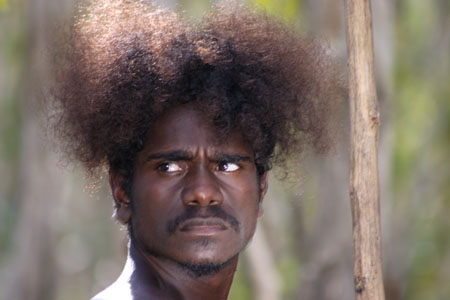|
Reviews of Recent Independent, Foreign, & Documentary Films in Theaters and DVD/Home Video
Directed by: Rolf de Heer. Co-Directed by: Peter Djigirr. Written by: Rolf de Heer in consultation with the Ramingining community. Produced by: Rolf de Heer & Julie Ryan. Photographed by: Ian Jones. Edited by: Tania Nehme. Released by: Palm Pictures. Language: Yolngu with English subtitles & narration. Country of Origin: Australia. 90 min. Not Rating. With: Jamie Dayindi Gulpilil Dalaithngu, Crusoe Kurddal, Richard Birrinbirrin, Peter Minygululu, Frances Djulibing, Sonia Djarrabalminym & Cassandra Malangarri Baker. DVD Features: The Balanda and the Bark Canoes: The Making of Ten Canoes (55 min.) Aerial map of Arnhem Land. Interview with Rolf de Heer. Interview with Peter Djigirr. Photo gallery: Thomson photographs revisited. DVD-Rom study guide (19 pages). Trailers.
While there is also an international version of Ten Canoes with Gulpilil narrating in his native Mandalpingu dialect with English subtitles,
his bemused and enlightening English narration is a wonderful element of this film’s charm. Unseen, Gulpilil takes on the role of the Storyteller,
a cultural interpreter for non-aboriginal audiences, relating and commenting on the plot. He teases, beginning with “a long time ago in a land far,
far away” – and cracks up at the Star Wars reference as the camera glides along the bush into the farthest reaches of Australia’s
Northern Territory, deep into the Arafura Swamp.
Gulpilil’s folksy voice leads back and forth along a two-pronged tale, accompanied by the haunting didgeridoo on the soundtrack, with many actors
portraying parallel characters in both tales. In the first, shot in black and white,
clan patriarch, Minygululu (played by Peter Minygululu), realizes his younger brother, Dayindi (David Gulpilil’s son Jamie), has a dangerously roving
eye for his young third wife. Saying “Maybe this story will help you live the proper way,” the bearded mentor sets out to teach the rebellious young
man a lesson during a week-long goose egg hunting expedition by canoe. (Midway through, after building canoes and a camp site high up in the trees
away from the crocodiles, the elder asks Dayindi if he’s learned anything yet. The younger retorts “Only that you take too long to tell a story.”)
Minygululu’s cautionary tale-within-the tale, filmed in color, takes place “in the time just after the beginning,” where, from the single men’s hut,
a flirtatious Yeeralparil (also played by Jamie) lustfully eyes the pretty and youngest wife of his rugged older brother, who has another wife
who mysteriously disappears, setting off a violent crisis for all the villagers and the strangers they confront from other clans. All the characters
are very much
individuals, from amusing to tragic, and as ironically up-to-date as the Mormons in HBO’s Big Love.
The sense of straddling many time frames and two cultures gives this film a different perspective than the also beautiful The Fast Runner
(Atanarjuat), which reenacted an Inuit legend with an indigenous cast and language. De Heer and his long-time production team are particularly
adept at breaking through barriers, whether in a cross-cultural work or entering into the mind of a child without condescension in the 1996 film
The Quiet Room.
National Geographic-type nudity and earthy dialogue about bodily functions and desires will probably keep prudish school authorities from
formally allowing students to see this unrated film, but it is enchantingly educational about oral and cultural traditions. Parents who are
comfortable with their children seeing such images and subjects from a rarely seen spiritual point of view can take those old enough to comfortably
read subtitles.
David Gulpilil’s tremendous impact on the image of native Australians in cinema and how he balances his dance, film, and theater work with his
traditional family life in the town of Ramingining, where Ten Canoes was shot, is informatively presented in the documentary One Red Blood by
Darlene Johnson, available on the DVD of The Tracker. Doubtlessly, the insights of indigenous Australians will be seen in the future, with
Ten Canoes already spawning a multitude of artistic and educational projects in his home town (named Eleven Canoes,
Twelve Canoes and so on).
Nora Lee Mandel
DVD Extras: It’s rare when a making-of featurette spills the beans on a production’s
mishaps and hurdles. Director de Heer staidly narrates the 55-minute “The Balanda and the Bark Canoes.” (Balanda means white man, meaning de Heer.)
While filming the canoeing scenes in the swamps, mosquitoes, leeches, and crocodiles were temporary annoyances. The long-term problem throughout the
shoot was keeping the non-professional cast unified and focused. One actor bolted before the first take, when he, like the other men, would have had
to become naked. And de Heer learns maybe there can be too much rehearsal when his cast’s energy flags right before it’s time to film a scene.
The photo gallery offers several side-by-side comparisons between anthropologist Donald Thomson’s 1930s photos of the Yolngu people and the film’s
production stills. Ten Canoe’s compositions and the actors’ actions were inspired by the photos of the earlier generation. Thomson’s work was
not solely a starting point for the director and cast. It captured cultural traditions now lost. Of the 11,000 photos taken by Thomson, de Heer
examined 2,000 during pre-production. Kent Turner
|

